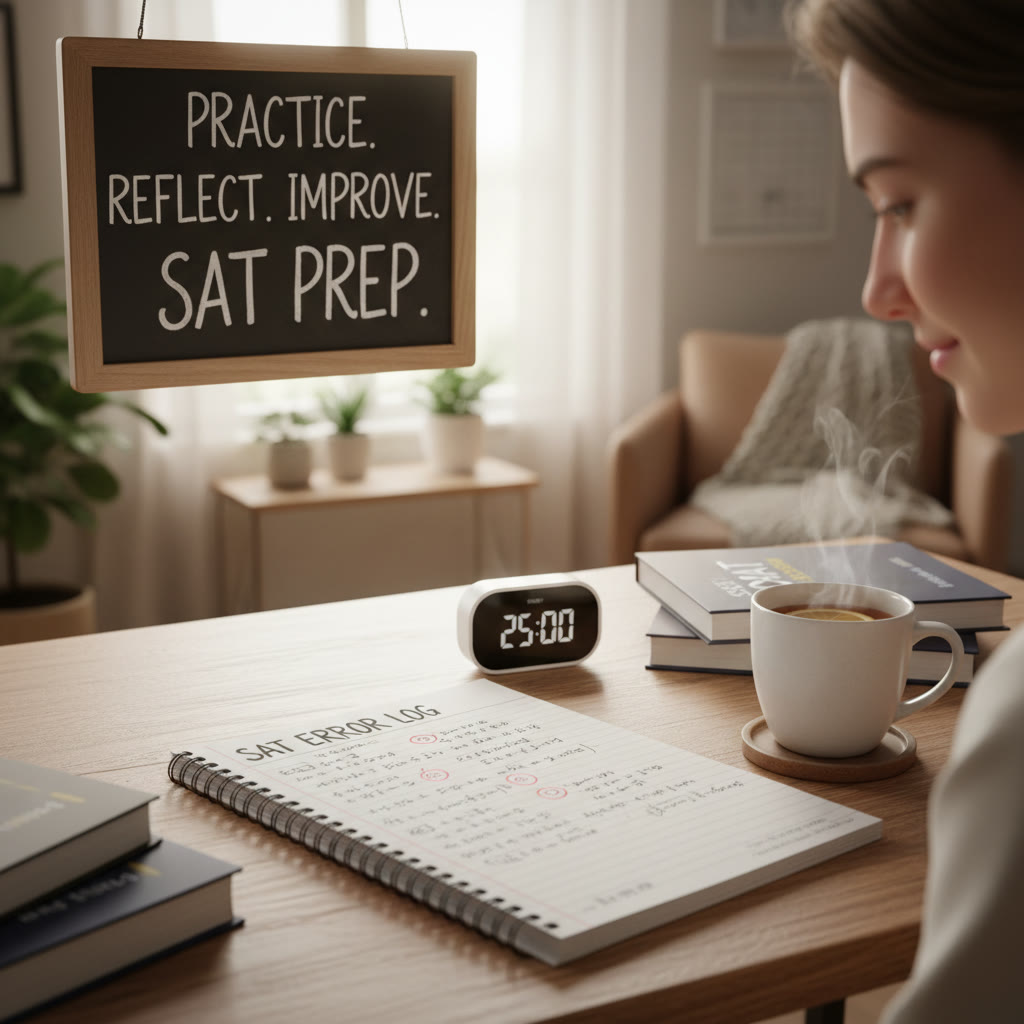Introduction: The Comfort of Familiar Territory
There’s a quiet thrill when you pull up an old practice test and see questions you’ve already answered. You remember a sentence completion you missed, you nod at a geometry diagram, and you think: “This time I’ll ace it.” Retaking the same practice test is tempting. It’s immediate feedback, a quick confidence boost, and—crucially—it’s measurable.
But that measurable improvement can be misleading. Familiarity creates a different skill than the one the SAT is testing. The goal of practice should be to improve your ability to tackle unseen problems under pressure, not to memorize one specific set of questions.
What Actually Changes When You Retake the Same Test
1. Memory vs. Mastery
When you see a question twice, your brain will often remember the path you took to the right answer. That memory can masquerade as understanding. You might correctly pick an answer because you recall eliminating two choices last time, not because you’ve deepened your conceptual grasp.
Example: In a reading passage you initially misread a paragraph and missed a detail. On the second pass you remember that detail and answer correctly. Did you get better at reading dense passages, or did you simply recall a line you had already read?
2. Reduced Anxiety, Not Increased Skill
Test anxiety drops on a second run through a familiar test. Reduced anxiety improves performance, but that doesn’t necessarily transfer to the actual SAT with different content or a different pacing pressure. Lower anxiety on a repeated practice test can falsely inflate your sense of readiness.
3. Gaming the Test, Not Learning It
Repeated exposure teaches you the structure of that particular form of the test, the style of the question writers, and sometimes even the tricks the authors used. This is useful only to the extent those patterns appear on the real test—patterns that will likely differ if the practice test is drawn from the same small pool.
4. Measurement Noise and Score Fluctuation
All standardized tests have some degree of measurement error and natural score variance. Small gains on repeat attempts—say a 10–20 point increase on a section—can easily lie within the test’s normal fluctuations. That means a slight uptick after a retake might not indicate meaningful improvement.
Concrete Examples: How Retakes Can Lead You Astray
Let’s walk through a few realistic student scenarios to make this concrete.
Aisha: The Overconfident Repeater
Aisha takes Practice Test A and scores a 620 on Math. She reviews, retakes the same test two weeks later, and scores 690. Elated, she cancels her longer study plan and registers for the SAT thinking she’s ready. On test day she scores 640. What happened?
- She remembered many answers and processes from the practice test.
- Her study did not address underlying concept gaps—only question-specific mistakes.
- Test-day conditions reintroduced unfamiliar wording and timing stress.
Miguel: The False Positive
Miguel used the same reading passages three times. Each retake showed steady improvement as he grew familiar with the passages, but his ability to handle new passages didn’t improve. On a new practice test, his reading score stagnated. Familiarity had inflated his earlier gains.
Why Variation Beats Repetition
Effective practice mimics the conditions and variety of the real SAT. Variety builds a robust skill set; repetition on identical items builds an item-specific memory. Here’s why varied practice matters:
- Generalizes skills to new problems.
- Exposes gaps that only appear under different question phrasing.
- Simulates the surprise factor and variety of the actual exam.
When a Retake Can Be Useful (If Done Carefully)
That said, retaking a test can be informative—when used intentionally. Here are conditions under which a retake might help:
- Time gap: Wait at least two weeks and study targeted concepts between attempts.
- Change the conditions: Time yourself strictly, simulate test-day breaks, or switch your environment.
- Do a blind review: After the first attempt, don’t memorize answers; instead, focus on error patterns and problem types to address.
- Use retakes sparingly: One retake to test mastery of fixed errors can be helpful, but avoid repeatedly running the same test.
How to Make a Retake Diagnostic Instead of Deceptive
- Write down mistakes and the reasoning error before retaking. That prevents simple memory from being your main advantage.
- Reconstruct the reasoning without looking at the answers first.
- Swap sections: Switch the order of sections or interleave problem types to force fresh thinking.
Smart Alternatives to Repeating the Same Test
Here are practice strategies that more reliably lead to real SAT score improvement.
1. Use Multiple Full-Length Practice Tests
Rotation of tests provides a broad sample of question styles and difficulty. Track trends across different practice tests to identify true improvement rather than test-specific familiarity.
2. Focused, Targeted Practice
After each test, use an error log: note the exact mistake, the underlying concept, and a small practice set to correct that issue. For instance, if you miss algebraic manipulation problems repeatedly, isolate 20 tailored algebra practice questions until accuracy improves.
3. Spaced Repetition and Mixed Practice
Return to concepts periodically rather than all at once. Mix problem types in each study session to avoid pattern recognition that only applies to a single question type.
4. Simulate Test Conditions, Not Test Content
Practice under realistic timings, with breaks, and in a quiet environment. That conditions your body and mind to perform under test-day constraints rather than on a particular set of questions.
Small Table: Comparing Practice Approaches
| Approach | Short-term Effect | Long-term Reliability | Best Use |
|---|---|---|---|
| Retake same test immediately | Scores often jump | Low — gains often reflect memory | Quick confidence checks after targeted review |
| Retake after spaced study | Moderate gains if concept gaps fixed | Medium — diagnostic if interval and study are meaningful | Confirm concept mastery |
| Use different practice tests | Variable, realistic | High — shows transferable skill gains | Best for realistic performance tracking |
| Targeted micro-practice | Slow, steady improvement | High — builds specific skills | Fix recurring errors and improve weak areas |
Practical Steps You Can Take Right Now
If you’ve been retaking the same test out of habit, here’s a simple plan to get your prep back on track in four steps.
Step 1: Stop the Endless Retake Cycle
- Limit yourself to one retake of the same test, only after targeted review and at least a two-week gap.
Step 2: Create a Focused Error Log
- For every incorrect question, record: the question type, your mistake, the correct method, and two new practice problems of that type to try later.
Step 3: Mix in New Full-Length Tests Weekly
- Rotate official practice tests and high-quality third-party forms to simulate variety.
- Score them under test conditions to track a reliable trend.
Step 4: Use Targeted Study Between Tests
- Spend at least half your study time on targeted weaknesses instead of redoing whole tests.
- Use focused drills: 15–30 minute sessions on specific skills (algebra manipulation, passage mapping, thesis-identification in reading).
How Tutors and Smart Tools Can Help
A thoughtful tutor can spot when retaking a test is informative versus when it just feeds false confidence. Personalized guidance helps you distinguish between real skill growth and test-memory effects.
For example, Sparkl’s personalized tutoring pairs 1-on-1 guidance with tailored study plans and expert tutors who can design practice that avoids the trap of repeated exposure. Their AI-driven insights can analyze error patterns across different tests and suggest the right mix of practice tests, timed sections, and focused drills so your study time builds transferable skills—not only memorized answers.
Common Objections—and Why They Fall Short
“But I want to see my progress quickly.”
Quick progress is appealing, but lasting improvement usually looks gradual. Short-term spikes from third or fourth identical test runs tell you more about recall than competence. Instead of chasing quick wins, aim for measurable trends across different tests.
“I feel more confident when I retake the same test.”
Confidence is valuable, but it must be earned. If that confidence relies largely on memory, it won’t protect you on a different form of the SAT. Use practice variety to build confidence that reflects generalized ability.
“It’s efficient to retake a test because I don’t have time to find new tests.”
Spending time on targeted practice develops skills more efficiently than repeating the same items. Consider slicing your time: 60% on varied full-length practice, 40% on targeted drills. A tutor or an organized plan can make finding and rotating tests effortless.
Checklist: Before You Decide to Retake Any Test
- Did you wait at least two weeks and study relevant concepts in between?
- Did you avoid memorizing answers and instead focus on understanding mistakes?
- Have you run at least one different full-length practice test for comparison?
- Are you tracking whether gains generalize across multiple test forms?
Final Thoughts: Practice with Purpose
Retaking the same practice test is not inherently bad. It becomes bad when it becomes a habit that disguises the difference between memory and mastery. The SAT measures your ability to handle new, unseen problems under time pressure—not your ability to remember a particular passage or diagram.
Make your practice purposeful: mix tests, isolate weaknesses, simulate test conditions, and measure trends across diverse materials. If you want help converting test results into an effective plan, consider tutoring that blends human expertise with smart analytics. Sparkl’s personalized tutoring—offering tailored study plans, expert tutors, 1-on-1 guidance, and AI-driven insights—can help you focus on transferable skills rather than false positives from repeated retakes.
Closing Action Plan (10 Minutes to Start)
- Open your most recent practice test and create an error log for five mistakes you made.
- Write one specific skill you’ll drill for 20 minutes tomorrow based on those errors.
- Schedule one different full-length practice test for two weeks from now under strict timing.


Keep your practice honest, varied, and intentional. Real gains take time, but they’re far more durable than the short-lived glow of a repeated test score. Study smart, track trends, and let your progress be the kind that transfers to test day—new problems, new passages, real improvement.



















No Comments
Leave a comment Cancel